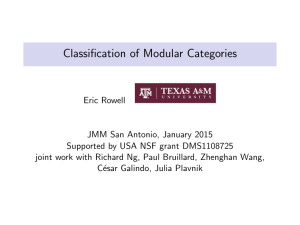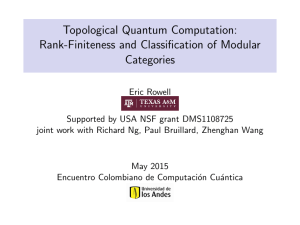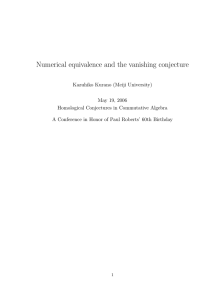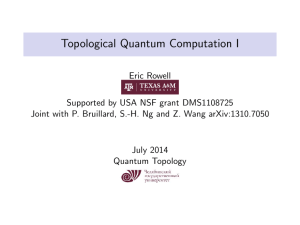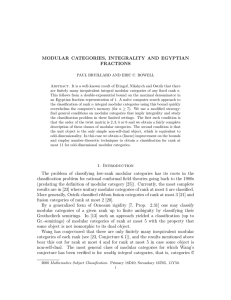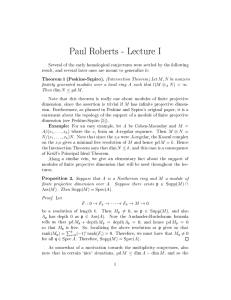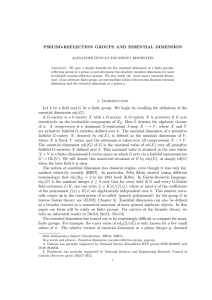Classification of Modular Categories
advertisement
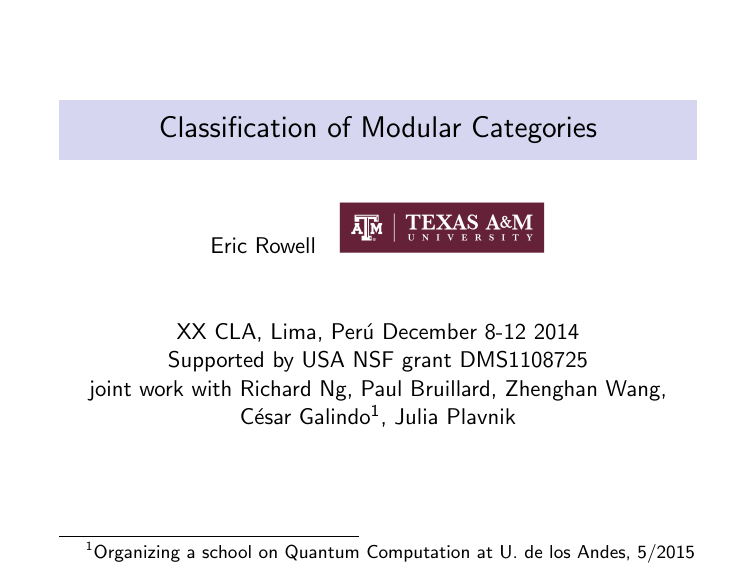
Classification of Modular Categories
Eric Rowell
XX CLA, Lima, Perú December 8-12 2014
Supported by USA NSF grant DMS1108725
joint work with Richard Ng, Paul Bruillard, Zhenghan Wang,
César Galindo1 , Julia Plavnik
1
Organizing a school on Quantum Computation at U. de los Andes, 5/2015
Definition
A modular category C (over C) is
monoidal: (⊗, 1), L
semisimple: X ∼
= i mi Xi ,
linear: Hom(X , Y ) ∈ VecC ,
rigid: X ∗ ⊗ X 7→ 1 7→ X ⊗ X ∗ ,
finite rank: Irr(C) = {1 = X0 , . . . , Xr −1 },
spherical: uX θX : X ∼
= X ∗∗ , dim(X ) ∈ R,
braided: cX ,Y : X ⊗ Y ∼
= Y ⊗ X,
modular: det(TrC (cXi ,Xj∗ cXj∗ ,Xi )) 6= 0.
Remark
I
uX is Drinfeld isomorphism, θ is ribbon structure, satisfying,
e.g.: θX ⊗Y = θX ⊗ θY (cY ,X cX ,Y )
I
TrC : End(X ) → C is the pivotal trace.
Heuristic Definitions
I
Definition (Physics)
The algebraic models of elementary excitations of topological
phases of matter are modular categories.
I
Definition (Algebra)
Modular categories axiomatize Rep(U) where U is a modular Hopf
algebra. E.g. Drinfeld doubles: D ω G .
I
Definition (Topology)
Modular categories classify [some] 2 + 1-topological quantum field
theories.
Key Data
I
I
L
fusion rules: Xi ⊗ Xj ∼
= k Nijk Xk
S-matrix: Sij := TrC (cXi ,Xj∗ cXj∗ ,Xi )
I
T -matrix: Tij = δij θi
I
Level: N = ord(T )
I
Dimension: dim(C) :=
I
Ambient fields: Q(S) := Q(Sij : 0 ≤ i, j ≤ r − 1) and
Q(θi : 0 ≤ i ≤ r − 1) = Q(T ).
Pr −1
i=0
2
Si0
I
Definition (In Coordinates)
For S, T ∈ C(r ,r ) define dj := S0j , θj := Tjj , D 2 :=
P
p± := j dj2 θj±1 . (S, T ) admissible if:
P
j
dj2 ,
t
1. S = S t , SS = D 2 Id, T diagonal, ord(T ) = N < ∞
N
2. (ST )3 = p+ S 2 , p+ p− = D 2 , pp−+
=1
P
S S S
3. Nijk := a iaD 2jada ka ∈ N
P k
4. θi θj Sij = a Ni ∗ j dk θk where Nii0∗ uniquely defines i ∗ .
n
P
5. νn (k) := D12 i,j Nijk di dj θθji
∈ Z[ζN ] satisfies:
ν2 (k) ∈ {0, ±1}
6. Q(S) ⊂ Q(T ), AutQ Q(S) ⊂ Sr , AutQ(S) Q(T ) ∼
= (Z2 )k .
2
7. Prime (ideal) divisors of hD i and hNi coincide in Z[ζN ].
Conjecture: Any admissible (S, T ) determines a modular category.
Note: 1&2 imply (S, T ) yields ρ : SL(2, Z) → PU(r ).
Sources
I
Pointed: C(A, q), A finite abelian group, q non-degenerate
quad. form on A.
I
Rep(D ω G ), ω a 3-cocycle on G a finite group.
Quantum groups/Kac-Moody algebras: subquotients of
Rep(Uq g) at q = e πi/` or level k integrable ĝ-modules. e.g.
I
I
I
I
I
I
SU(N)k = C(slN , N + k),
SO(N)k ,
Sp(N)k ,
for gcd(N, k) = 1, PSU(N)k ⊂ SU(N)k “even half”
Drinfeld center: Z(D) for spherical fusion category D.
Example
SU(2)`−2 from Rep(Uq sl2 ) at q = e πi/`
I
simple objects {X0 = 1, X1 , . . . , X`−2 }
I
Sij =
I
X1 ⊗ Xk ∼
= Xk−1 ⊕ Xk+1 for 1 ≤ k ≤ ` − 3
I
θj = e
I
sin(
(i+1)(j+1)π
)
`
sin( π` )
πi(j 2 +2j)
2`
so ord(T ) = 4`
P
2
D 2 = dim SU(2)`−2 = `−1
n=1 [n] where [n] =
Remark
q n −q −n
.
q−q −1
√
Special case: ` = 5: dim SU(2)3 = 5 + 5, ord(T ) = 20.
PSU(2)`−2 for ` odd: subcategory with simple objects X2i , 0 ≤ i.
For the rest of this talk, we assume dim(X ) > 0 for all X .
Problem
Classify “small” modular categories.
E.g.:
I
Bounded dimension: dim(C) < M
I
Bounded rank: r < M,
I
few primes: |{p ∈ Spec Z[ζN ] : p | dim(C)}| < M
I
Bounded level: ord(T ) < M
Rank-Finiteness
Theorem (Bruillard,Ng,R,Wang 2013)
There are finitely many modular categories of a given rank r .
History:
I
(2003) Conjectured by Wang, verified for rank = 2 (Ostrik).
I
(2005) Verified for: fusion categories with dim(C) ∈ N
(Etingof, Nikshych and Ostrik), rank= 3 (Ostrik).
I
(2009-10) Verified for: rank = 4 (R,Stong,Wang), rank = 5
non-self-dual (R,Hong).
Warm Up
Theorem (E. Landau 1903)
For any r ∈ N, there are finitely many groups G with |Irr (G )| = r .
Proof.
Use class equation:
|G | =
r
X
|gi |,
i=1
gi distinct conjugacy classes. Set xi = [G : C (gi )] (index of
centralizers) to get
r
X
1
1=
.
xi
i=1
xi ≤ a(r ) where a(1) = 2, a(2) = 3, a(n) = a(n − 1)a(n − 2) + 1 is
Sylvester’s sequence. Therefore |G | = maxi xi is bounded.
Recall dim(C) :=
P
j
dim(Xi )2 .
Lemma
For any M > 0, there are finitely many rank = r fusion categories
C with dim(C) < M.
Proof.
k ≤ dim(C) so follows from Ocneanu Rigidity† .
Ni,j
† There are finitely many fusion (and modular) categories with
given fusion rules Nijk .
A little number theory...
For N = ord(T ) and ζN a primitive Nth root of 1, set:
SC = {p ∈ Spec Z[ζN ] : p|hdim(C)i}.
Example (C = SU(2)3 )
√
I
N = ord(T ) = 20 and dim(C) = 5 +
5
I
Prime factorization: in Z[ζ20 ], hdim(C)i = h2ih1 − (ζ20 )4 i2
I
Thus: SC = {h2i, h1 − (ζ20 )4 i}
For each r define:
[
Sr :=
SC
rank(C)=r
Proposition (BNRW)
|Sr | < ∞ implies rank-finiteness.
Proof requires (analytic) number theory...
Let K be a number field and S ⊂ Spec OK be finite. The S-units
are:
Y
×
OK,S
= {x ∈ K : hxi =
pαp }
p∈S
where αp ∈ Z.
Theorem (Evertse 1984)
There are finitely many solutions to 0 = 1 + x0 + · · · + xr −1 with
×
xi ∈ OK,S
such that no sub-sum of 1 + x0 + · · · + xr −1 vanishes.
Proof of Proposition.
|Sr | < ∞ & Evertse’s Theorem imply:
|{(− dim(C), (d1 )2 , . . . , (dr −1 )2 )}| < ∞.
In particular, dim(C) < M(r ). This gives rank-finiteness.
For C with N = ord(T ) set
MC = {p ∈ Spec Z[ζN ] : p|hNi},
Mr =
[
MC
rank(C)=r
Example (SU(2)3 )
4 i4 , so M
4
hNi = h20i = h2i2 h1 − ζ20
SU(2)3 = {h2i, h1 − ζ20 i}.
Proposition
|Mr | < ∞ implies rank-finiteness.
Follows from: Cauchy Theorem for Modular Categories
Proposition (Bruillard,Ng,R.,Wang)
Sr = Mr , i.e. hdim(C)i and hNi have the same prime divisors in
Z[ζN ].
Lemma
|Mr | < ∞.
Proof.
Enough to bound N < M(r ). Ng-Schauenburg Congruence
Subgroup Theorem implies modular representation ρ : SL(2, Z)
factors over SL(2, ZN ), minimal dimension of faithful SL(2, ZN )
representation bounds r < J(N), hence N < M(r ).
Rank-Finiteness for modular categories follows.
Low Rank Modular Categories
Theorem (R,Hong,Stong,Bruillard,Ng,Wang,Ostrik)
If 2 ≥ rank(C) ≤ 5 then C has the same fusion rules as one of:
I
PSU(2)3 (Fibonacci), SU(2)1 (pointed)
I
PSU(2)5 , SU(2)2 (Ising), SU(3)1 (pointed)
I
PSU(2)7 , SU(2)3 , SU(4)1 , products.
I
SU(2)4 , PSU(2)9 , SU(5)1 , PSU(3)4 .
Theorem (R,Bruillard)
I
Suppose C has ord(T ) ∈ {2, 3, 4}. Then C ⊂ Rep(D ω G ) for
some 2- or 3-group G .
I
Suppose dim(C) is odd and rank(C) ≤ 11. Then C is pointed.
Remark
I
ord(T ) = 6 implies integral, but not C ⊂ Rep(D ω G ).
I
Open: dim(C) odd, 13 ≤ rank(C) ≤ 23 implies pointed?
Tambara Yamagami Categories
C is weakly integral if dim(C) ∈ N.
Example
Let A be a finite abelian group, χ a non-degenerate bicharacter on
A and ν a sign. Tambara and Yamagami defined a spherical fusion
category TY (A, χ, ν) with simple objects A ∪ {m} with:
P
I m⊗m =
a∈A a
I
m⊗a=m
I
a ⊗ b = ab
dim(TY (A, χ, ν)) = 2|A|. ZTY (A, χ, ν) is modular.
Low Dimension Sample results
Theorem (Natale)
dim(C) < 36 and integral implies C is group-theoretical.
Theorem
(Bruillard,Galindo,Hong,Kashina,Naidu,Natale,Plavnik,R)
dim(C) = 36 and integral non-group theoretical is:
I
twist-equivalent to SU(3)3
I
TY (Z3 × Z3 , χ, τ )Z2 , χ elliptic.
Theorem (R,Ng,Bruillard,Wang,Galindo,Plavnik)
If C is:
I
weakly integral with rank(C) ≤ 7 or
I
dim(C) = 4m with m odd and square-free
then C ≡ D F where D, F ⊂ ZTY (A, χ, ν).
More explicitly: D, F are pointed, Ising or TY (Z2k+1 , χ, ν)Z2 .
Few Primes
Some classifications are known for C integral with:
I
dim(C) ∈ {p n , pq 2 , pq 3 , pq 4 , pq 5 , (pq)2 }. (various authors)
I
dim(X ) ∈ {1, p} (Natale,Plavnik).
I
dim(C) = pq n group-theoretical iff nilpotent (Dong,Tucker)
Thank you!
